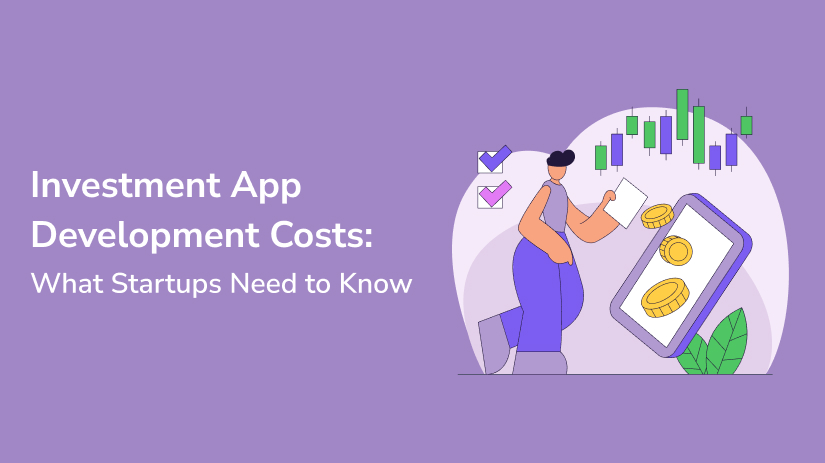In the fast-paced world of fintech, developing an investment app can be a lucrative endeavor for startups. However, understanding the costs involved in investment software development is crucial to ensure a successful launch and sustainable growth.
This blog will delve into the various expenses startups need to anticipate, from development and design to ongoing maintenance and compliance.
Initial Planning and Research
Before diving into development, extensive market research and planning are essential. Understanding the target audience, identifying key features, and analyzing competitors like top wealth management platforms can shape the direction of the project. This phase may involve:
- Market research costs
- Business analysis
- Initial legal consultations
Connect with us for Fintech Development Needs
Trusted by companies like Plaid, Yodlee, Codat.
Design and Prototyping
Creating a user-friendly and intuitive design is crucial for the success of any finance software system. This phase includes:
- User interface (UI) and user experience (UX) design
- Wireframing and prototyping
- User testing and feedback
Development Costs
The core of any investment app lies in its development. Choosing the right technology stack and a competent development team is vital. Partnering with a specialized ruby on rails development firm can offer robust and scalable solutions. Key development cost components include:
- Backend development
- Frontend development
- Integration with third-party APIs (e.g., stock market data, banking systems)
- Database management
Security and Compliance
Investment apps handle sensitive financial data, making security a top priority. Compliance with financial regulations (like GDPR, FINRA, SEC) adds to the complexity and cost. This phase involves:
- Implementing robust security protocols
- Regular security audits
- Legal consultations for compliance
Testing and Quality Assurance
Thorough testing ensures the app functions smoothly and securely. This involves:
- Unit testing
- Integration testing
- User acceptance testing (UAT)
- Bug fixing
Connect with us for Fintech Development Needs
Trusted by companies like Plaid, Yodlee, Codat.
Launch and Marketing
Once development is complete, launching the app and attracting users are the next steps. Costs here include:
- App Store and Google Play Store fees
- Marketing and advertising campaigns
- Public relations and brand awareness
Maintenance and Updates
Post-launch, ongoing maintenance, and regular updates are essential to keep the app competitive and secure. This includes:
- Bug fixes and improvements
- Adding new features
- Ensuring compatibility with new OS versions
Additional Features and Integrations
Depending on the app’s scope, integrating additional features like charity donation software can provide unique value to users. Custom features and integrations add to the overall development cost but can significantly enhance user engagement and retention.
Conclusion
Developing an investment app involves a multi-faceted approach, balancing initial costs with long-term benefits. By understanding these cost components, startups can better plan their budgets and make informed decisions.
Whether partnering with a ruby on rails development firm or integrating advanced finance software systems, the key is to create a secure, user-friendly platform that meets the needs of modern investors.
Investing in thorough planning, robust development, and continuous improvement will set the foundation for a successful investment app that stands out in the competitive fintech landscape.
Connect with us for Fintech Development Needs
Trusted by companies like Plaid, Yodlee, Codat.
Frequently Asked Questions (FAQs)
1. What are the initial steps to develop an investment app?
The initial steps include conducting market research, defining your target audience, analyzing competitors, and outlining key features for your app. This phase also involves business analysis and initial legal consultations to ensure compliance with financial regulations.
2. How important is design in developing an investment app?
Design is crucial as it impacts user experience and engagement. A user-friendly and intuitive design, achieved through UI/UX design, wireframing, prototyping, and user testing, can significantly enhance the app's appeal and usability.
3. What are the core development costs for an investment app?
Core development costs include backend and frontend development, integration with third-party APIs, and database management. Partnering with a specialized development firm, such as a ruby on rails development firm, can ensure a robust and scalable solution.
4. How do security and compliance affect development costs?
Security and compliance are critical in finance software systems due to the sensitive nature of financial data. Costs involve implementing security protocols, conducting regular security audits, and ensuring compliance with regulations like GDPR, FINRA, and SEC.
5. Why is testing and quality assurance important?
Testing and quality assurance ensure the app functions smoothly and securely. This involves unit testing, integration testing, user acceptance testing (UAT), and bug fixing, all of which are essential to delivering a reliable product.





